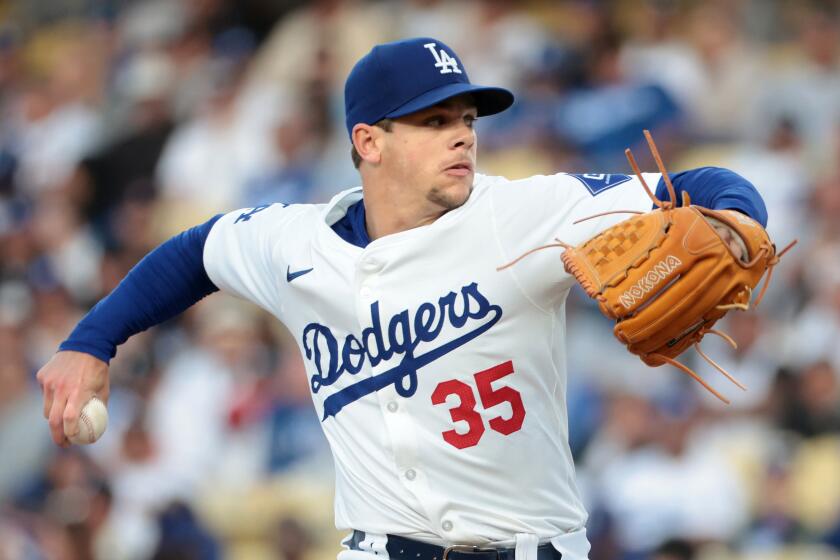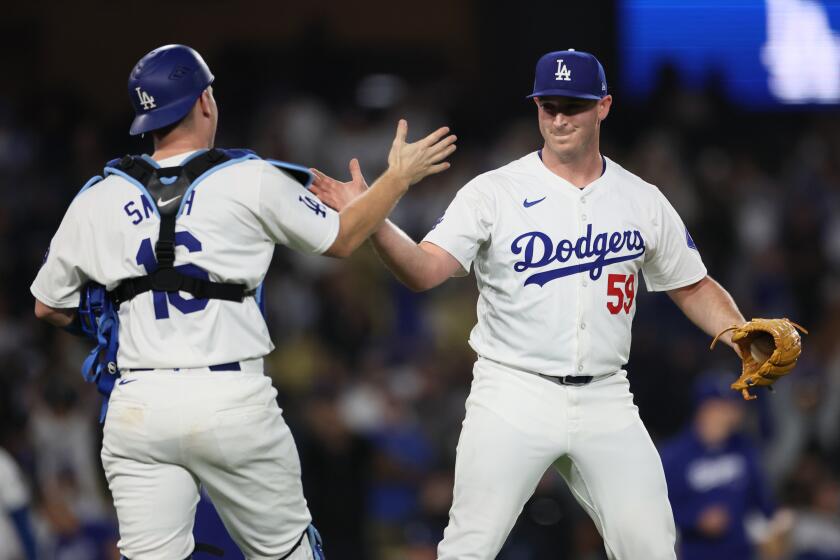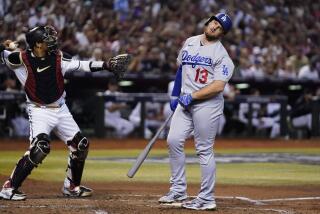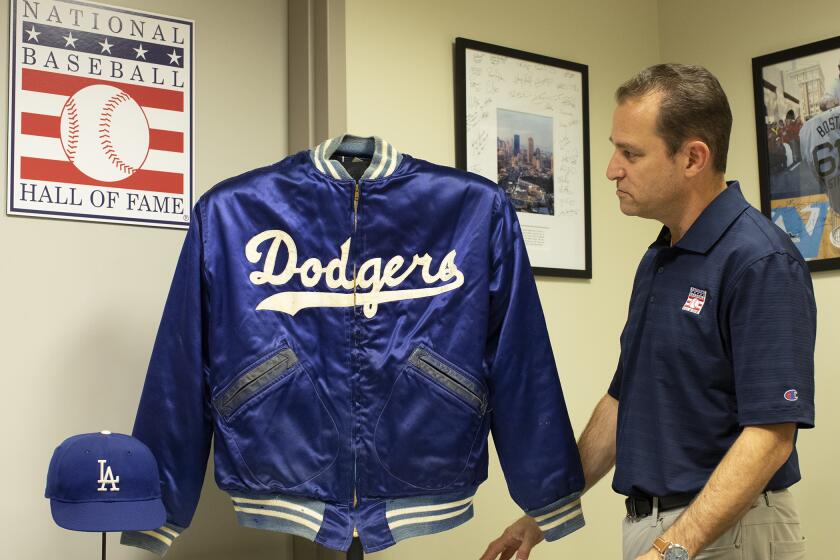Dodgers fall to Paul Skenes, Pirates; seek improvement against high-velocity fastballs
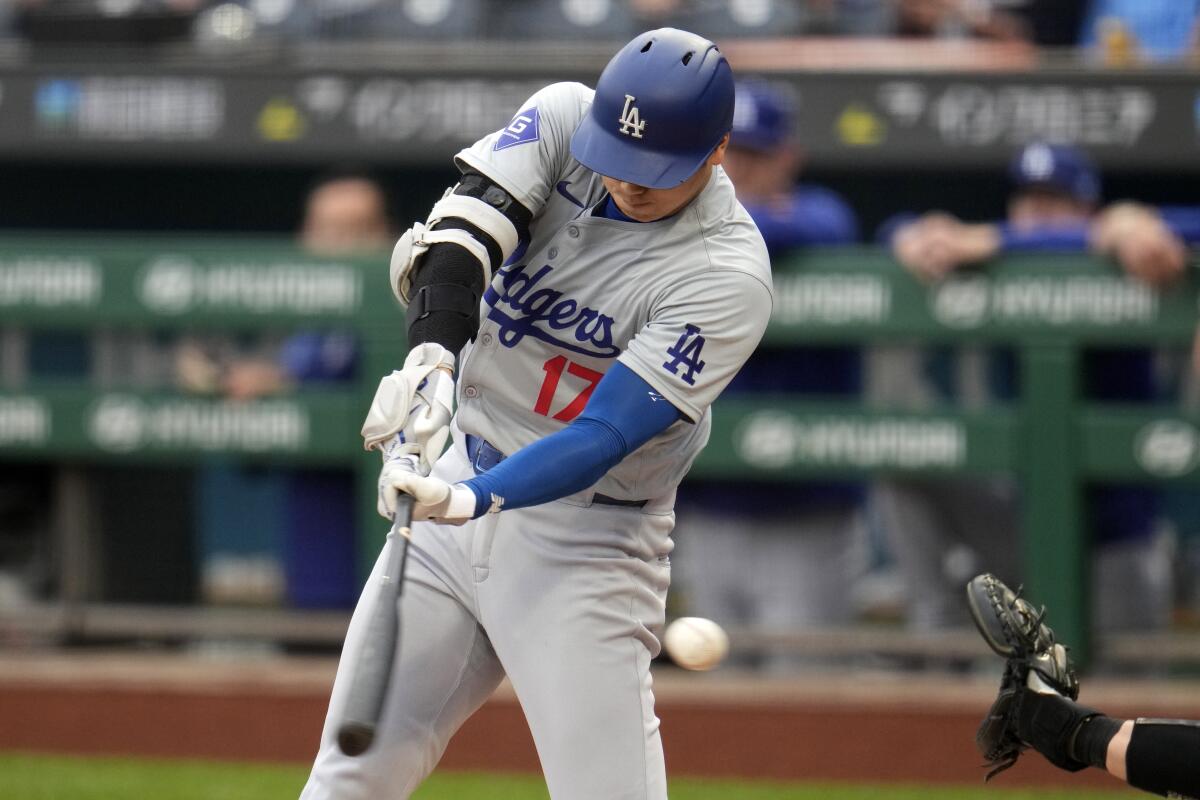
- Share via
PITTSBURGH — This week’s pitching matchups should have favored the Dodgers’ powerhouse lineup.
In their first two games against the Pittsburgh Pirates this week, the Dodgers faced a pair of rookie right-handers in Jared Jones and Paul Skenes. Both prospects are talented (and from Southern California-area high schools La Mirada and El Toro, respectively). Skenes, in particular, looks destined for stardom, already thriving in the big leagues less than a year after being drafted No. 1 overall.
Still, for the Dodgers’ star-studded offense and $300-million roster, a pair of unproven rookies figured to be manageable marks. After a couple of inconsistent weeks at the plate, it seemed like the time for the team’s bats to break back out.
There was only one problem.
Like an ever-growing number of MLB pitchers, Skenes and Jones both throw their fastballs hard. As in, near triple-digit hard.
Their biggest strength was the Dodgers’ greatest weakness.
Jones, who shut the Dodgers out over six innings in Tuesday’s 1-0 Pirates win, averages 97 mph with his fastball.
As Dodgers right-hander Gavin Stone has settled in as a starter this season, he is reminding the Dodgers of Orel Hershiser both in approach and in his competitiveness.
Skenes, who gave up three runs in five innings in Wednesday’s 10-6 Pirates win, routinely surpasses 100 mph.
In both games, the pitchers were victorious against the Dodgers’ talent-rich lineup. And on both nights, their fastball did the heavy lifting.
High-velocity fastballs have become an issue for the Dodgers this year; an unexpected weakness for a lineup that was supposed to feature as much raw talent as almost any in the majors.
Against all four-seamers, the Dodgers entered Wednesday ranked in the middle of the pack in the majors: 20th in batting average (.290), 15th in slugging percentage (.412) and 14th in whiff rate (21.4%).
Against fastballs thrown 97 mph or more, though, the Dodgers’ numbers plummet. They entered Wednesday batting just .124 on such pitches (second-to-last in the majors). They were slugging just .148 (dead last among all 30 teams). And of the 582 high-velocity heaters they’d faced, only three were turned into extra-base hits (all of them doubles).
“I think there’s a little bit of pause [in our approach], as far as making the decision and being a little too careful at times, trying to see the ball a little too long,” manager Dave Roberts said. While that can make hitters less susceptible to breaking stuff, Roberts noted, it also “causes you to be late on the heater.”
Granted, the Dodgers (38-25) have compensated to this point of the season, still ranking top-six in batting average, on-base plus slugging and scoring.
Wednesday’s game was better than most, too, with the Dodgers going five for 14 against Skenes’ highly touted heater — including a long home run from Shohei Ohtani in the third inning, after he whiffed on three straight fastballs in his first at-bat — albeit while striking out on the pitch six times.
“The stuff itself was really good,” said Ohtani, whose homer came on an elevated 100.1-mph pitch. “As you saw in my first at-bat, couldn’t really put together good swings … Rather than the velo, it’s really the angle and the release. So I made the adjustment the second at-bat.”
Still, the fastball weakness has appeared to be increasingly exploited by opponents of late.
No team has faced more fastballs than the Dodgers this season. And this week, Jones and Skenes both leaned on the pitch heavily. Jones threw it on 58 of his 100 pitches (only two of which resulted in hits). Skenes dialed it up 48 times in his 93-pitch outing (including 16 at 100 mph or harder).
“It’s like anything,” Roberts said. “Until you can show you can flip the script or do something different, then they’re going to continue to exploit that.”
How the Dodgers remedy the issue is less clear.
Roberts said it has been a point of emphasis lately among the team’s hitters and hitting coaches. As far back as a series in Cincinnati late last month, Freddie Freeman said it has been a topic of conversation in daily game-planning meetings.
“They let us know,” Freeman quipped then.
With the problem still lingering, though, Roberts raised a few new suggestions Wednesday, hinting that a more aggressive approach could pay dividends.
“I think you, at certain times, have to pick your spots to sell out to the fastball,” he said. “You have to make them respect the fact that you can turn the fastball around. I’m not saying every time. But you’ve got to kind of put that thought in a pitcher’s head in certain situations.”
Saturday’s win over Colorado marked the first time this season the Dodgers deployed the bullpen trio of Daniel Hudson, Blake Treinen and Evan Phillips.
On Wednesday, it might not have mattered much. The Pirates (29-32) chased pitcher James Paxton in the bottom of the second, after scoring seven runs in an 11-batter inning (Paxton has now given up 15 runs in 15⅓ innings over his last four starts). The bullpen yielded three late runs, quelling any comeback effort. The Dodgers’ defense committed a couple of costly errors as well.
But, come October, when the team could face a heavy dose of velocity from a better collection of arms in a postseason environment, their performance against fastballs could be of monumental importance.
Just how crucial?
“I think it’s probably the biggest barometer of successful hitters and clubs,” Roberts said. “Teams that can hit the fastball, that can hit velocity.”
To this point, the Dodgers haven’t done so consistently.
And this week, it contributed to a series loss against a sub-.500 opponent.
More to Read
Are you a true-blue fan?
Get our Dodgers Dugout newsletter for insights, news and much more.
You may occasionally receive promotional content from the Los Angeles Times.

